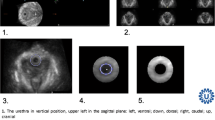Abstract
Purpose
The aim of this paper is to provide a method for measuring the internal anal sphincter on the basis of the quantitative analysis of three-dimensional endosonographic images. A software calculates a large set of measurements which are able to describe the three-dimensional shape of the muscle.
Methods
A software provides four types of measurements: thickness, length, area and volume. The different magnitudes are estimated using the same reference system. The measurements obtained are modeled by functions that describe their spatial trend. The precision and reproducibility of the method was tested on a phantom before a study was performed on fifteen healthy patients. The measurements were carried out by two different operators. The inter-observer variability were assessed.
Results
In the phantom measurements the mean errors and the standard deviation were: 0.05 ± 0.1 mm for the thickness, 0.02 ± 0.12 mm for the length, −4.43 ± 2.4 mm2 for the area, −20.69 ± 20.83 mm3 for the volume. The maximum absolute differences between the measurements carried out by the two operators was: 0.18 mm for the thickness (in the 95% of the case), 1.69 mm2 for the area (in the 95% of the case), and 0.25 mm for the length, and 29.46 mm3 for the volume. The human IAS assessments were evaluated on each segment. The mean of the all tissue measurements carried out were (mean ± SD): 1.71 ± 0.34 mm for the thickness, 33.24 ± 6.10 mm for the length, 111.28 ± 29.08 mm2 for the area. The mean of the volume measurements of the entire tissue was: 4124 ± 1160 mm3. Inter-observer variability was observed only in the anterior proximal segment for the thickness measurements by Wilcoxon’s signed rank test (P value = 0.048) and for the volume assessments by the limits of agreement method (−118to 78 mm3). The mean percentage errors and the limit of agreement for the measurements of the entire tissue were: 0.27 and (−0.11 to 0.12 mm) for the thickness, −2.32 and (−3.88 to 2.33 mm) for the length, −0.05 and (−9.71 to 9.83 mm2) for the area, −1.89 and (−366 to 240 mm3) for the volume.
Conclusion
The assessments of accuracy and precision of the method result satisfactory for all four type of measurements. The reproducibility analysis confirms very good inter-observer agreement for the phantom measurements and for the most part of the IAS segments evaluations. Inter-observer variability was seen only for the thickness and volume measurements of the anterior-proximal segment. Our method provides a high number of measurements with good accuracy enabling a very detailed study of IAS morphology.
Similar content being viewed by others
References
Malouf AJ et al (2000) Prospective assessment of accuracy of endoanal MR imaging and endosonography in patients with fecal incontinence. Am J Radiol 175: 741–745
Beets-Tan RGH et al (2001) Measurement of anal sphincter muscles: endoanal US, endoanal MR Imaging, or Phased-Array MR Imaging? A study with healthy volunteers. Radiology 220: 81–89
Schiessel R et al (2005) Technique and long-term results of intersphincteric resection for low rectal-cancer. Dis Colon Rectum 48(10): 1858–1865
Vaizey CJ et al (1997) Primary degeneration of the internal anal sphincter as a cause of passive faecal incontinence. Lancet 349: 612–615
Engin G (2006) Endosonographic imaging of anorectal diseases. J Ultrasound Med 25: 57–73
Sergio F et al (2007) Anal canal anatomy showed by three-dimensional anorectal. Surg Endosc 21: 2207–2211
Gold DM et al (1999) Intraobserver and interobserver agreement in anal endosonography. Br J Surg 86: 371–375
Sultan AH et al (1994) Endosonography of the anal sphincters: normal anatomy and comparison with manometry. Clin Radiol 49(6): 368–374
Frudinger A et al (2002) Female anal sphincter: age related differences in asymptomatic volunteers with high-frequency endoanal US. Radiology 224: 417–423
Tatsuya A et al (2008) Effect of aging and gender on internal anal sphincter thickness. Anti-Aging Med 5(3): 46–48
Wiliams AB et al (2002) Endosonographic anatomy of the normal anal canal compared with endocoil magnetic resonance imaging. Dis Colum Rectum 45: 176–183
Burnett SJD et al (1991) Endosonographic variations in the normal internal anal sphincter. Int J Colorect Dis 6: 2–4
Olsen IP et al (2006) Volume of the internal and external anal sphincter assessed by three-dimensional endoanal ultrasound. Ultrasound Obstet Gynecol 28: 359–411
West RL et al (2005) Volume measurement of the anal sphincter complex in healthy controls and fecal incontinent patients with a three-dimensional reconstruction of endoanal ultrasonography images. Dis Colon Rectum 48: 540–548
Olsen IP et al (2008) Three-dimensional endoanal ultrasound assessment of the anal sphincters: reproducibility. Acta Obstetricia et Ginecologica Scandinavica 675(681): 675–681
Falcao AX et al (1999) An ultra-fast user-steered image segmentation paradigm: live-wire-on-the-fly. SPIE Med Imaging 3661: 184–191
Huebner M et al (2007) Age effects on internal anal sphincter thickness and diameter in nulliparous females. Dis Colon Rectum 50(9): 1405–1411
Author information
Authors and Affiliations
Corresponding author
Rights and permissions
About this article
Cite this article
Sboarina, A., Minicozzi, A. & Cordiano, C. New method for internal anal sphincter measurements: feasibility study. Int J CARS 5, 515–525 (2010). https://doi.org/10.1007/s11548-010-0406-y
Received:
Accepted:
Published:
Issue Date:
DOI: https://doi.org/10.1007/s11548-010-0406-y




